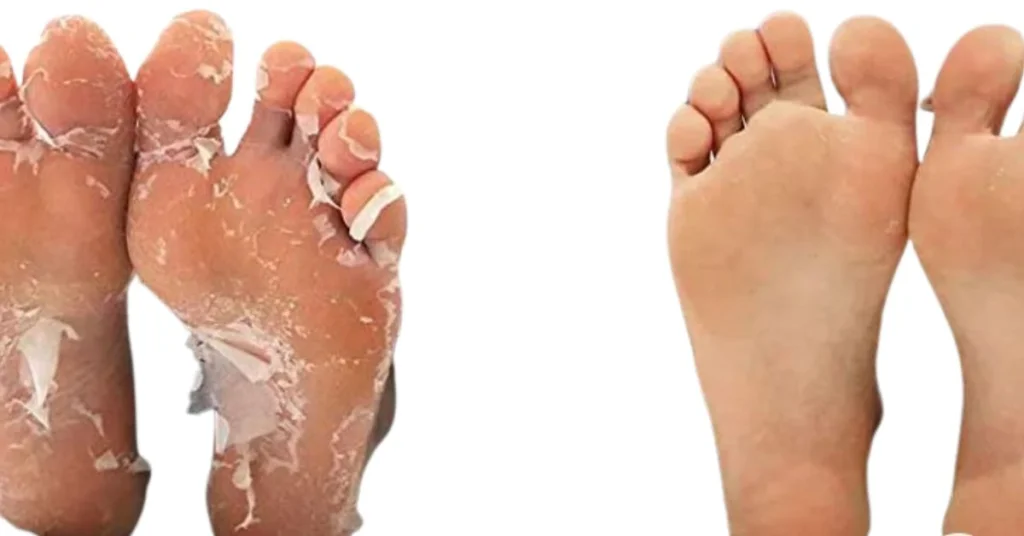Can I use a foot mask while breastfeeding?
Experts generally recommend exercising caution when using skincare products during this period.
Thank you for reading this post, don't forget to subscribe!Consult a healthcare provider or dermatologist before using new skincare products, including foot masks, while breastfeeding.
It ensure the safety of both the mother and the baby, as some ingredients in skincare products may be absorbed into the bloodstream and potentially passed on to the infant through breast milk.
Does a foot mask make your feet peel
Click Here For MoreFoot masks are a popular addition to foot care routines, offering various benefits such as exfoliation and hydration. These masks typically contain ingredients like exfoliating acids, moisturizing agents, and nourishing oils to help soften rough skin and calluses.
Exfoliating foot masks work by gently removing dead skin cells through the action of exfoliating ingredients like AHAs or BHAs. This process reveals smoother, softer skin underneath. Regular use of foot masks can help maintain healthy feet and improve the skin’s overall appearance.
Understanding the ingredients in foot masks is essential for choosing the right product for your needs. Look for key ingredients like glycolic acid, salicylic acid, shea butter, or coconut oil that target concerns such as dryness, roughness, or cracked heels. Incorporating a foot mask into your regular foot care routine can provide an extra pampering step to keep your feet looking and feeling their best.
What are the disadvantages of a foot peel mask?

Foot peel masks have gained popularity for their exfoliating properties, but it’s essential to consider the potential disadvantages before trying them.
One common issue with foot peel masks is that they can cause skin irritation or allergic reactions, especially for individuals with sensitive skin. The ingredients in the mask, such as acids or other exfoliants, may be too harsh for some people and lead to discomfort.
Another downside of foot peel masks is that they can be time-consuming and require several days to see results. During the peeling process, which can last up to a week, your feet may look unsightly and feel rough or dry.
It’s also essential to note that foot peel masks may not suit everyone, particularly those with certain medical conditions like diabetes or circulation problems. Consulting a healthcare professional before using a foot mask is advisable.
While foot peel masks can effectively remove dead skin and calluses, it’s essential to be aware of their potential drawbacks and proceed with caution when using them.
Face Razor For Women – Groom At Home Any Time
Why Foot Masks Lead to Exfoliation
When using foot masks, it’s common to experience peeling due to the exfoliation process. This skin shedding is a natural phenomenon due to chemical and biological exfoliation mechanisms.
Chemical exfoliation in foot masks often involves ingredients like alpha hydroxy acids (AHAs) or beta hydroxy acids (BHAs) that work to break down dead skin cells and promote shedding. On the other hand, natural exfoliation occurs as part of the skin’s renewal cycle, where old skin cells slough off to reveal newer, healthier skin underneath.
Understanding the science behind peeling feet after using foot masks can help individuals appreciate the benefits of this process for smoother and softer feet.
Is foot peeling healthy?
Foot peeling, primarily through foot mask products like foot peel masks, can benefit some individuals’ skincare routine. These products typically contain ingredients that help to exfoliate and remove dead skin cells from the feet, revealing smoother and softer skin.
It is essential to follow the instructions with foot peel masks carefully to ensure safe and effective use. Some people may experience mild irritation or sensitivity after using these products, so performing a patch test before completing the application is advisable.
When used correctly and in moderation, foot peeling can contribute to maintaining healthy and well-groomed feet. However, individual experiences may vary, so it is best to consult a dermatologist or healthcare professional if you have concerns about using foot peel masks.
What happens if you leave a foot peel mask on too long?
Leaving a foot peel mask on for too long can lead to potential skin irritation or damage. These masks typically contain active ingredients like acids or enzymes that help exfoliate and peel away dead skin cells. However, if left on for an extended period beyond the recommended time, they can cause over-exfoliation, resulting in redness, sensitivity, or even chemical burns.
It’s essential to follow the instructions provided with the foot mask to avoid adverse effects. Suppose you accidentally leave the mask on too long and experience discomfort or unusual reactions. In that case, it is advisable to rinse off the product immediately and consult a healthcare professional if necessary. Suppose you experience pain or unusual reactions from leaving the foot mask on too long. In that case, it is crucial to rinse off the product immediately and seek advice from a healthcare professional if needed.
Pros and Cons of Using Foot Mask for Exfoliating and Softening Your Feet
Using foot masks for exfoliating and softening your feet can provide various benefits. Foot masks, especially foot peels, are designed to remove dead skin cells, leaving your feet feeling smoother and softer. They can help improve the appearance of rough or calloused feet, making them look more attractive.
However, there are some risks associated with using foot masks. Some people may experience skin irritation or allergic reactions to the ingredients in the mask. It is essential to read the instructions carefully and perform a patch test before using a foot mask to avoid adverse reactions.
When considering foot treatment options, weighing the pros and cons of using foot masks compared to other methods, such as manual exfoliation or professional pedicures, is essential. Each option has its own benefits and risks, so choosing the one that best suits your needs and preferences is important.


